Gas-Wetting Alteration by Fluorochemicals and Its Application for Enhancing Gas Recovery in Gas-Condensate Reservoirs: A Review
Abstract
1. Introduction
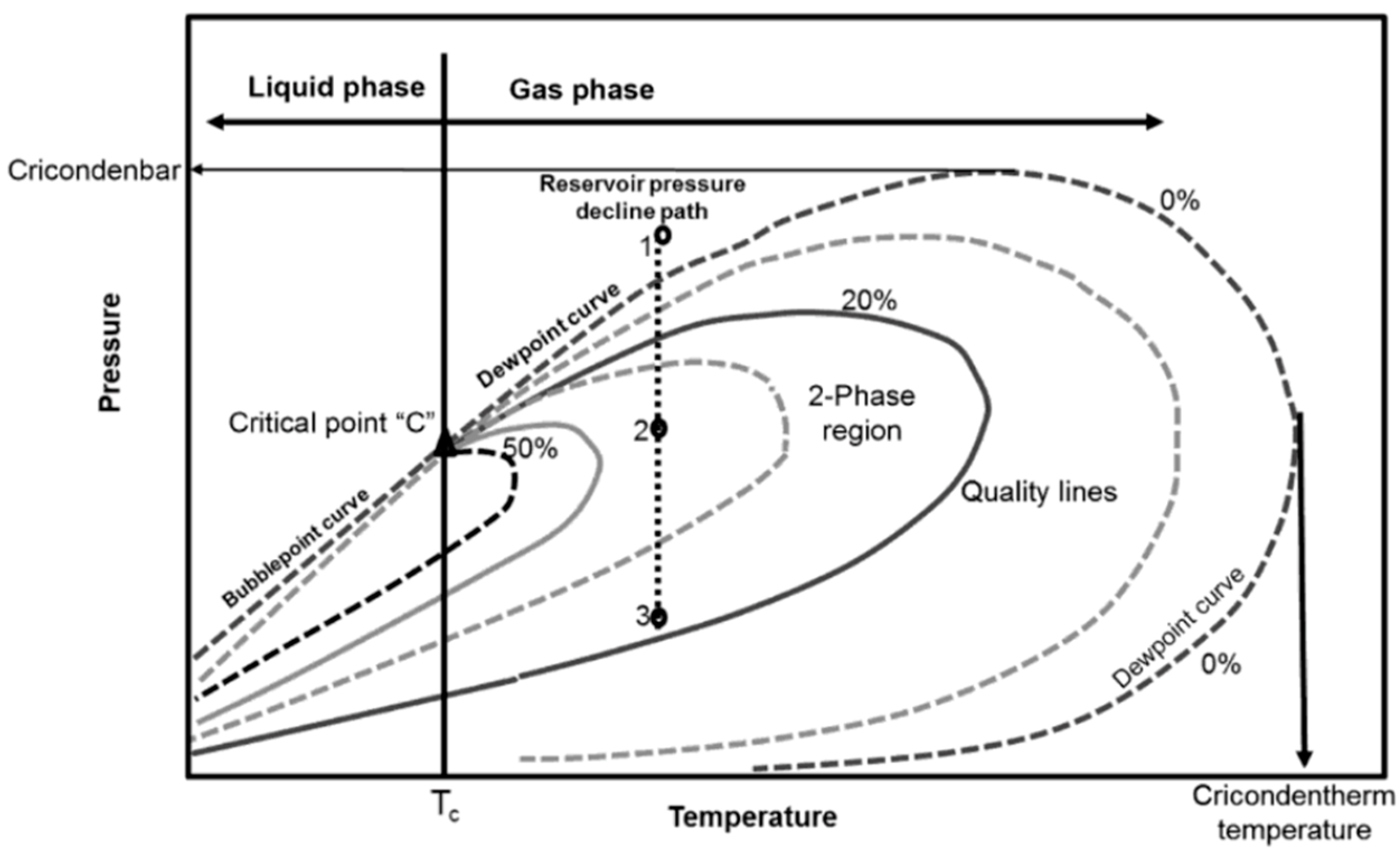
2. Gas-Wetting Alteration and Its Effect on EOR
2.1. Gas-Wetting Alteration
2.2. Wettability Alteration
2.3. Gas-Wetting Measurement
2.3.1. Static Contact Angle Measurement
2.3.2. Owens–Wendt–Rabel–Kaelble Method
2.3.3. Spontaneous Imbibition Test
2.3.4. Capillary Rise Test
2.3.5. Nuclear Magnetic Resonance Technique
2.3.6. Streaming Potential Measurement
3. Properties of Fluorochemicals
3.1. Fluorosurfactants
3.2. Fluoropolymers
3.3. Fluorochemical-Modified Nanoparticles
3.4. Morphologies of Fluorochemicals and Modified Nanomaterials

4. Effects of Factors on Fluorochemicals
4.1. Temperature
4.2. pH
4.3. Salinity
4.4. Zeta Potential
5. Effects of Fluorochemicals on Fluids in Porous Media
5.1. Effect on Liquid Saturation
5.2. Effect on Flow Behavior in Porous Media
5.2.1. Detachment
5.2.2. The Transition of the Liquid Bridge
5.3. Gas-Wetting Model
6. Outlook/Future
7. Summary
- (1)
- The liquid-blocking effect occurring during the development of the gas-condensate reservoir has aroused wide attention because of its severe damage; gas-wetting alteration by fluorochemicals could be regarded as a promising remediation approach;
- (2)
- The methods for evaluating the gas-wetting of reservoir rock were summarized; the factors that affect gas-wetting were investigated;
- (3)
- Varying sizes and kinds of nanomaterials can be modified by fluorochemicals, the mechanisms of fluorochemicals adsorption layer with varying surface morphologies were illustrated; the surfaces with more air cavities tend to exhibit stronger gas-wetting;
- (4)
- The flow behavior of the fluids in a gas-wetting pore throat is distinctly different from that in a liquid-wetting pore throat. The wetting regime of the solid surface with gas-wetting might be a complex of the Wenzel regime and the Cassie-Baxter regime.
Author Contributions
Funding
Acknowledgments
Conflicts of Interest
References
- Coskuner, G. Performance Prediction In Gas Condensate Reservoirs. J. Can. Pet. Technol. 1999, 38, 32–36. [Google Scholar] [CrossRef]
- Yang, D.; Zhu, G.; Liu, J.; Su, J.; Zhang, B.; Fei, A. Distribution of global condensate gas field and major factors controlling its formation. Earth Sci. Front. 2010, 17, 339–349. [Google Scholar]
- Vošta, M. Global changes and new trends within the territorial structure of the oil, gas and coal industries. Acta Oeconomica Pragensia 2009, 17, 45–59. [Google Scholar] [CrossRef]
- Miller, N. Increasing Well Productivity in Gas Condensate Wells in Qatar’s North Field. Master Thesis, Texas A & M University, College Station, TX, USA, 2010. [Google Scholar]
- Fan, L.; Harris, B.W.; Jamaluddin, A.J.; Kamath, J.; Mott, R.; Pope, G.A.; Shandrygin, A.; Whitson, C.H. Understanding gas-condensate reservoirs. Oilfield Rev. 2005, 10, 16–25. [Google Scholar]
- Shi, C. Flow Behavior of Gas-Condensate Wells; Stanford University: Stanford, CA, USA, 2009. [Google Scholar]
- Sayed, M.A.; Al-Muntasheri, G.A. Mitigation of the Effects of Condensate Banking: A Critical Review. SPE Prod. Oper. 2015, 13, 205–212. [Google Scholar] [CrossRef]
- Alvarado, V.; Manrique, E. Enhanced oil recovery: An update review. Energies 2010, 3, 1529–1575. [Google Scholar] [CrossRef]
- Ganie, K.; Idris, A.K.; Mohshim, D.F.; Wan Sulaiman, W.R.; Mohd Saaid, I.; Abdul Malik, A. A review on the wettability alteration mechanism in condensate banking removal. J. Pet. Sci. Eng. 2019, 183, 106431. [Google Scholar] [CrossRef]
- Noh, M.H.; Firoozabadi, A. Wettability Alteration in Gas-Condensate Reservoirs to Mitigate Well Deliverability Loss by Water Blocking. SPE Reserv. Eval. Eng. 2008, 11, 676–685. [Google Scholar] [CrossRef]
- Ahmed, T. Reservoir Engineering Handbook; Gulf Professional Publishing: Houston, TX, USA, 2018. [Google Scholar]
- Li, K.; Abbas, F. Experimental Study of Wettability Alteration to Preferential Gas-Wetting in Porous Media and Its Effects. SPE Reserv. Eval. Eng. 2000, 3, 139–149. [Google Scholar]
- Ganjdanesh, R.; Rezaveisi, M.; Pope, G.A.; Sepehrnoori, K. Treatment of Condensate and Water Blocks in Hydraulic-Fractured Shale-Gas/Condensate Reservoirs. SPE J. 2016, 21, 665–674. [Google Scholar] [CrossRef]
- Li, K.; Firoozabadi, A. Phenomenological Modeling of Critical Condensate Saturation and Relative Permeabilities in Gas/Condensate Systems. SPE J. 2000, 5, 138–147. [Google Scholar] [CrossRef]
- Wu, S.; Firoozabadi, A. Permanent Alteration of Porous Media Wettability from Liquid-Wetting to Intermediate Gas-Wetting. Transp. Porous Media 2010, 85, 189–213. [Google Scholar] [CrossRef]
- Wang, Y.; Jin, J.; Ma, L.; Li, L.; Zhao, X. Influence of Wettability Alteration to Preferential Gas-Wetting on Displacement Efficiency at Elevated Temperatures. J. Dispers. Sci. Technol. 2015, 36, 1274–1281. [Google Scholar] [CrossRef]
- Tang, G.Q.; Firoozabadi, A. Wettability Alteration to Intermediate Gas-Wetting in Porous Media at Elevated Temperatures. Transp. Porous Media 2003, 52, 185–211. [Google Scholar] [CrossRef]
- Feng, C.; Kong, Y.; Jiang, G.; Yang, J.; Pu, C.; Zhang, Y. Wettability modification of rock cores by fluorinated copolymer emulsion for the enhancement of gas and oil recovery. Appl. Surf. Sci. 2012, 258, 7075–7081. [Google Scholar] [CrossRef]
- Sheydaeemehr, M.; Sedaeesola, B.; Vatani, A. Gas-condensate production improvement using wettability alteration: A giant gas condensate field case study. J. Nat. Gas Sci. Eng. 2014, 21, 201–208. [Google Scholar] [CrossRef]
- Liu, Y.; Zheng, H.; Huang, G.; Li, G.; Li, K. Improving Production in Gas/Condensate Reservoirs by Wettability Alteration to Gas Wetness, In Proceedings of the SPE/DOE Symposium on Improved Oil Recovery, Tulsa, OK, USA, 22–26 April 2006; Society of Petroleum Engineers: Richardson, TX, USA, 2006.
- Moncayo-Riascos, I.; Hoyos, B.A. Fluorocarbon versus hydrocarbon organosilicon surfactants for wettability alteration: A molecular dynamics approach. J. Ind. Eng. Chem. 2020, 88, 224–232. [Google Scholar] [CrossRef]
- Cassie, A.; Baxter, S. Wettability of porous surfaces. Trans. Faraday Soc. 1944, 40, 546–551. [Google Scholar] [CrossRef]
- Erfani Gahrooei, H.R.; Ghazanfari, M.H. Application of a water based nanofluid for wettability alteration of sandstone reservoir rocks to preferentially gas wetting condition. J. Mol. Liq. 2017, 232, 351–360. [Google Scholar] [CrossRef]
- Alvarez, J.O.; Schechter, D.S.J.S.R.E. Engineering, Wettability alteration and spontaneous imbibition in unconventional liquid reservoirs by surfactant additives. SPE Reserv. Eval. Eng. 2017, 20, 107–117. [Google Scholar] [CrossRef]
- Wang, B.; Zhang, Y.; Shi, L.; Li, J.; Guo, Z. Advances in the theory of superhydrophobic surfaces. J. Mater. Chem. 2012, 22, 20112–20127. [Google Scholar] [CrossRef]
- Hazlett, R.; Chen, S.; Soll, W. Wettability and rate effects on immiscible displacement: Lattice Boltzmann simulation in microtomographic images of reservoir rocks. J. Pet. Sci. Eng. 1998, 20, 167–175. [Google Scholar] [CrossRef]
- Morrow, N.R.; Xie, X. Oil recovery by spontaneous imbibition from weakly water-wet rocks. Petrophysics 2001, 42. [Google Scholar]
- Standnes, D.C.; Nogaret, L.A.D.; Chen, H.-L.; Austad, T. An Evaluation of Spontaneous Imbibition of Water into Oil-Wet Carbonate Reservoir Cores Using a Nonionic and a Cationic Surfactant. Energy Fuels 2002, 16, 1557–1564. [Google Scholar] [CrossRef]
- Anderson, W.G. Wettability Literature Survey-Part 6: The Effects of Wettability on Waterflooding. J. Pet. Technol. 1987, 39, 1605–1622. [Google Scholar] [CrossRef]
- Anderson, W. Wettability literature survey-part 2: Wettability measurement. J. Pet. Technol. 1986, 38, 1246–1262. [Google Scholar] [CrossRef]
- Butt, H.-J.; Semprebon, C.; Papadopoulos, P.; Vollmer, D.; Brinkmann, M.; Ciccotti, M. Design principles for superamphiphobic surfaces. Soft Matter 2013, 9, 418–428. [Google Scholar] [CrossRef]
- Jin, J.; Wang, Y.; Nguyen, T.A.; Nguyen, A.V.; Wei, M.; Bai, B. The effect of gas-wetting nano-particle on the fluid flowing behavior in porous media. Fuel 2017, 196, 431–441. [Google Scholar] [CrossRef]
- Wang, Y.; Gong, X. Superhydrophobic Coatings with Periodic Ring Structured Patterns for Self-Cleaning and Oil–Water Separation. Adv. Mater. Interfaces 2017, 4, 1700190. [Google Scholar] [CrossRef]
- Azadi Tabar, M.; Ghazanfari, M.H.; Dehghan Monfared, A. On the size-dependent behavior of drop contact angle in wettability alteration of reservoir rocks to preferentially gas wetting using nanofluid. J. Pet. Sci. Eng. 2019, 178, 1143–1154. [Google Scholar] [CrossRef]
- Yeh, K.-Y.; Chen, L.-J.; Chang, J.-Y. Contact Angle Hysteresis on Regular Pillar-like Hydrophobic Surfaces. Langmuir 2008, 24, 245–251. [Google Scholar] [CrossRef]
- Marmur, A.; Della Volpe, C.; Siboni, S.; Amirfazli, A.; Drelich, J.W.J.S.I. Contact angles and wettability: Towards common and accurate terminology. Surf. Innov. 2017, 5, 3–8. [Google Scholar] [CrossRef]
- Xia, F.; Jiang, L.J. Bio-inspired, smart, multiscale interfacial materials. Adv. Mater. 2008, 20, 2842–2858. [Google Scholar] [CrossRef]
- Yuan, Y.; Lee, T.R. Contact angle and wetting properties. In Surface Science Techniques; Springer: Berlin/Heidelberg, Germany, 2013; pp. 3–34. [Google Scholar]
- Good, R.J. Surface free energy of solids and liquids: Thermodynamics, molecular forces, and structure. J. Colloid Interface Sci. 1977, 59, 398–419. [Google Scholar] [CrossRef]
- Wu, S.; Brzozowski, K.J. Surface free energy and polarity of organic pigments. J. Colloid Interface Sci. 1971, 37, 686–690. [Google Scholar] [CrossRef]
- Van Oss, C.J.; Chaudhury, M.K.; Good, R.J. Interfacial Lifshitz-van der Waals and polar interactions in macroscopic systems. Chem. Rev. 1988, 88, 927–941. [Google Scholar] [CrossRef]
- Owens, D.K.; Wendt, R. Estimation of the surface free energy of polymers. J. Appl. Polym. Sci. 1969, 13, 1741–1747. [Google Scholar] [CrossRef]
- Gindl, M.; Sinn, G.; Gindl, W.; Reiterer, A.; Tschegg, S. A comparison of different methods to calculate the surface free energy of wood using contact angle measurements. Colloids Surf. A: Physicochem. Eng. Asp. 2001, 181, 279–287. [Google Scholar] [CrossRef]
- Neumann, A.; Good, R.; Hope, C.; Sejpal, M. An equation-of-state approach to determine surface tensions of low-energy solids from contact angles. J. Colloid Interface Sci. 1974, 49, 291–304. [Google Scholar] [CrossRef]
- Wang, S.; Zhang, Y.; Abidi, N.; Cabrales, L.J.L. Wettability and surface free energy of graphene films. Langmuir 2009, 25, 11078–11081. [Google Scholar] [CrossRef]
- Brownscombe, E.; Dyes, A. Water-imbibition displacement—Can it release reluctant Spraberry oil. Oil Gas J. 1952, 50, 264–265. [Google Scholar]
- Zhang, D.L.; Liu, S.; Puerto, M.; Miller, C.A.; Hirasaki, G.J. Engineering, Wettability alteration and spontaneous imbibition in oil-wet carbonate formations. J. Pet. Sci. Eng. 2006, 52, 213–226. [Google Scholar] [CrossRef]
- Morrow, N.R.; Mason, G. Recovery of oil by spontaneous imbibition. Curr. Opin. Colloid Interface Sci. 2001, 6, 321–337. [Google Scholar] [CrossRef]
- Washburn, E.W. The dynamics of capillary flow. Phys. Rev. 1921, 17, 273. [Google Scholar] [CrossRef]
- Yang, B.; Chang, Q. Wettability studies of filter media using capillary rise test. Sep. Purif. Technol. 2008, 60, 335–340. [Google Scholar] [CrossRef]
- Dullien, F.A.L.; Zarcone, C.; Macdonald, I.F.; Collins, A.; Bochard, R. The effects of surface roughness on the capillary pressure curves and the heights of capillary rise in glass bead packs. J. Colloid Interface Sci. 1989, 127, 362–372. [Google Scholar] [CrossRef]
- Siebold, A.; Walliser, A.; Nardin, M.; Oppliger, M.; Schultz, J. Capillary rise for thermodynamic characterization of solid particle surface. J. Colloid Interface Sci. 1997, 186, 60–70. [Google Scholar] [CrossRef]
- Galet, L.; Patry, S.; Dodds, J. Determination of the wettability of powders by the Washburn capillary rise method with bed preparation by a centrifugal packing technique. J. Colloid Interface Sci. 2010, 346, 470–475. [Google Scholar] [CrossRef]
- Looyestijn, W.J.; Hofman, J. Engineering, Wettability-index determination by nuclear magnetic resonance. SPE Reserv. Eval. Eng. 2006, 9, 146–153. [Google Scholar] [CrossRef]
- Liang, C.; Xiao, L.; Zhou, C.; Wang, H.; Hu, F.; Liao, G.; Jia, Z.; Liu, H. Wettability characterization of low-permeability reservoirs using nuclear magnetic resonance: An experimental study. J. Pet. Sci. Eng. 2019, 178, 121–132. [Google Scholar] [CrossRef]
- Jackson, M.D.; Vinogradov, J. Impact of wettability on laboratory measurements of streaming potential in carbonates. Colloids Surf. A: Physicochem. Eng. Asp. 2012, 393, 86–95. [Google Scholar] [CrossRef]
- Rahbar, M.; Pahlavanzadeh, H.; Ayatollahi, S.; Manteghian, M. Predicting the rock wettability changes using solutions with different pH, through streaming potential measurement. J. Pet. Sci. Eng. 2018, 167, 20–27. [Google Scholar] [CrossRef]
- Fina, B.L.; Rigalli, A. The Chemistry of Fluorine. In Fluorine; Royal Society of Chemistry: London, UK, 2015; pp. 41–53. [Google Scholar]
- Ameduri, B.; Boutevin, B. Well-Architectured Fluoropolymers: Synthesis, Properties and Applications; Elsevier: Amsterdam, The Netherlands, 2004. [Google Scholar]
- Zielecka, M.; Bujnowska, E. Silicone-containing polymer matrices as protective coatings: Properties and applications. Prog. Org. Coat. 2006, 55, 160–167. [Google Scholar] [CrossRef]
- Wang, J.L.; Chen, T.Y.; Chien, Y.H.; Su, G.D. Miniature optical autofocus camera by micromachined fluoropolymer deformable mirror. Opt. Express 2009, 17, 6268–6274. [Google Scholar] [CrossRef] [PubMed]
- Graunke, T.; Schmitt, K.; Raible, S.; Wöllenstein, J. Towards Enhanced Gas Sensor Performance with Fluoropolymer Membranes. Sensors 2016, 16, 1605. [Google Scholar] [CrossRef] [PubMed]
- Xu, W.; Hao, L.; An, Q.; Wang, X. Synthesis of fluorinated polyacrylate/polysilsesquioxane composite soap-free emulsion with partial trilayer core-shell structure and its hydrophobicity. J. Polym. Res. 2015, 22, 1–8. [Google Scholar] [CrossRef]
- Speight, J.G. Gas condensate. In Natural Gas, 2nd ed.; Speight, J.G., Ed.; Gulf Professional Publishing: Boston, MA, USA, 2019; pp. 325–358. [Google Scholar]
- Woodward, I.; Schofield, W.C.E.; Roucoules, V.; Badyal, J.P.S. Super-hydrophobic Surfaces Produced by Plasma Fluorination of Polybutadiene Films. Langmuir 2003, 19, 3432–3438. [Google Scholar] [CrossRef]
- Anton, D. Surface-Fluorinated Coatings. Adv. Mater. 1998, 10, 1197–1205. [Google Scholar] [CrossRef]
- Kovalchuk, N.M.; Trybala, A.; Starov, V.; Matar, O.; Ivanova, N. Fluoro- vs hydrocarbon surfactants: Why do they differ in wetting performance? Adv. Colloid Interface Sci. 2014, 210, 65–71. [Google Scholar] [CrossRef]
- Fahimpour, J.; Jamiolahmady, M. Optimization of Fluorinated Wettability Modifiers for Gas/Condensate Carbonate Reservoirs. SPE J. 2015, 20, 729–742. [Google Scholar] [CrossRef]
- Jin, J.; Wang, H.; Jing, Y.; Liu, M.; Wang, D.; Li, Y.; Bao, M. An efficient and environmental-friendly dispersant based on the synergy of amphiphilic surfactants for oil spill remediation. Chemosphere 2019, 215, 241–247. [Google Scholar] [CrossRef] [PubMed]
- Kamal, M.S.; Sultan, A.S.; Al-Mubaiyedh, U.A.; Hussien, I.A.; Pabon, M. Evaluation of Rheological and Thermal Properties of a New Fluorocarbon Surfactant–Polymer System for EOR Applications in High-Temperature and High-Salinity Oil Reservoirs. J. Surfactants Deterg. 2014, 17, 985–993. [Google Scholar] [CrossRef]
- Siddiqui, M.A.Q.; Gajbhiye, R.N.; Sultan, A.S.; Abu-Khamsin, S. Testing the Stability of Mixed CO2/N2-Foam Using New Fluorosurfactant for Enhanced Oil Recovery. In Proceedings of the SPE Kuwait Oil and Gas Show and Conference, Mishref, Kuwai, 11–14 October 2015; Society of Petroleum Engineers: Mishref, Kuwait, 2015; p. 9. [Google Scholar]
- Nandwani, S.K.; Chakraborty, M.; Gupta, S. Adsorption of Surface Active Ionic Liquids on Different Rock Types under High Salinity Conditions. Sci. Rep. 2019, 9, 14760. [Google Scholar] [CrossRef] [PubMed]
- You, L.; Zhang, W.; Kang, Y.; Chen, Z.; Liu, X. Stability of Fluorosurfactant Adsorption on Mineral Surface for Water Removal in Tight Gas Reservoirs. J. Chem. 2015, 2015, 980439. [Google Scholar] [CrossRef]
- Rojas, O.J.; Macakova, L.; Blomberg, E.; Emmer, Å.; Claesson, P.M. Fluorosurfactant Self-Assembly at Solid/Liquid Interfaces. Langmuir 2002, 18, 8085–8095. [Google Scholar] [CrossRef]
- McKeen, L.W. Chapter 11—Fluoropolymers. In Fatigue and Tribological Properties of Plastics and Elastomers, 2nd ed.; McKeen, L.W., Ed.; William Andrew Publishing: Oxford, UK, 2010; pp. 249–264. [Google Scholar]
- Feng, C.; Kong, Y.; Jiang, G.; Yang, J.; Zhang, Y. Alteration of Porous Media Wettability to Gas-Wetting by Sol-Gel and Fluorochemical Surfactant. Pet. Sci. Technol. 2014, 32, 1898–1904. [Google Scholar] [CrossRef]
- Marion, P.; Beinert, G.; Juhué, D.; Lang, J. Core−Shell Latex Particles Containing a Fluorinated Polymer in the Shell. 2. Internal Structure Studied by Fluorescence Nonradiative Energy Transfer. J. Appl. Polym. Sci. 1997, 64, 2409–2419. [Google Scholar] [CrossRef]
- Misra, A.; Urban, M.W. Acorn-Shape Polymeric Nano-Colloids: Synthesis and Self-Assembled Films. Macromol. Rapid Commun. 2010, 31, 119. [Google Scholar] [CrossRef]
- De Gennes, P.-G. Soft matter. Rev. Mod. Phys. 1992, 64, 645. [Google Scholar] [CrossRef]
- Jiang, G. Gas Wettability of Reservoir Rock Surfaces with Porous Media; Gulf Professional Publishing: Houston, TX, USA, 2018. [Google Scholar]
- He, L.; Nie, M.; Liang, G. Preparation and feasibility analysis of fluoropolymer to the sandstone protection. Prog. Org. Coat. 2008, 62, 206–213. [Google Scholar]
- Feng, C.; Huang, X. Preparation and Self-assembly of Amphiphilic Fluoropolymers. In Fluorinated Polymers: Volume 1: Synthesis, Properties, Processing and Simulation; The Royal Society of Chemistry: London, UK, 2017; Volume 1, pp. 276–306. [Google Scholar]
- Betancur, S.; Carrasco-Marín, F.; Franco, C.A.; Cortés, F.B. Development of Composite Materials Based on the Interaction between Nanoparticles and Surfactants for Application in Chemical Enhanced Oil Recovery. Ind. Eng. Chem. Res. 2018, 57, 12367–12377. [Google Scholar] [CrossRef]
- Franco, C.A.; Zabala, R.; Cortés, F.B. Nanotechnology applied to the enhancement of oil and gas productivity and recovery of Colombian fields. J. Pet. Sci. Eng. 2017, 157, 39–55. [Google Scholar] [CrossRef]
- Mousavi, M.A.; Hassanajili, S.; Rahimpour, M.R. Synthesis of fluorinated nano-silica and its application in wettability alteration near-wellbore region in gas condensate reservoirs. Appl. Surf. Sci. 2013, 273, 205–214. [Google Scholar] [CrossRef]
- Jin, J.; Wang, Y.; Nguyen, T.A.; Bai, B.; Ding, W.; Bao, M. Morphology and surface chemistry of gas-wetting nanoparticles and their effect on the liquid menisci in porous media. Ind. Eng. Chem. Res. 2019, 58, 6747–6755. [Google Scholar] [CrossRef]
- Jin, J.; Wang, Y.; Ren, J.; Nguyen, A.V.; Nguyen, T.A. The effect of fluoropolymer on wettability alteration of sandstone at elevated temperatures. J. Surfactants Deterg. 2016, 19, 1241–1250. [Google Scholar] [CrossRef]
- Villegas, J.P.; Moncayo-Riascos, I.; Galeano-Caro, D.; Riazi, M.; Franco, C.A.; Cortés, F.B. Functionalization of γ-Alumina and Magnesia Nanoparticles with a Fluorocarbon Surfactant to Promote Ultra-Gas-Wet Surfaces: Experimental and Theoretical Approach. Acs Appl. Mater. Interfaces 2020, 12, 13510–13520. [Google Scholar] [CrossRef]
- Esmaeilzadeh, P.; Sadeghi, M.T.; Fakhroueian, Z.; Bahramian, A.; Norouzbeigi, R. Wettability alteration of carbonate rocks from liquid-wetting to ultra gas-wetting using TiO2, SiO2 and CNT nanofluids containing fluorochemicals, for enhanced gas recovery. J. Nat. Gas Sci. Eng. 2015, 26, 1294–1305. [Google Scholar] [CrossRef]
- Yuan, B.; Wood, D.A. A comprehensive review of formation damage during enhanced oil recovery. J. Pet. Sci. Eng. 2018, 167, 287–299. [Google Scholar] [CrossRef]
- Feng, X.; Zhai, J.; Jiang, L. The Fabrication and Switchable Superhydrophobicity of TiO2 Nanorod Films. Angew. Chem. Int. Ed. 2005, 44, 5115–5118. [Google Scholar] [CrossRef]
- Kango, S.; Kalia, S.; Celli, A.; Njuguna, J.; Habibi, Y.; Kumar, R. Surface modification of inorganic nanoparticles for development of organic–inorganic nanocomposites—A review. Prog. Polym. Sci. 2013, 38, 1232–1261. [Google Scholar] [CrossRef]
- Hoseinpour, S.-A.; Madhi, M.; Norouzi, H.; Soulgani, B.S.; Mohammadi, A.H. Condensate blockage alleviation around gas-condensate producing wells using wettability alteration. J. Nat. Gas Sci. Eng. 2019, 62, 214–223. [Google Scholar] [CrossRef]
- Jin, J.; Wang, Y.; Wang, K.; Ren, J.; Bai, B.; Dai, C. The effect of fluorosurfactant-modified nano-silica on the gas-wetting alteration of sandstone in a CH4-liquid-core system. Fuel 2016, 178, 163–171. [Google Scholar] [CrossRef]
- Kumar, N.; Varanasi, K.; Tilton, R.D.; Garoff, S.J.L. Surfactant self-assembly ahead of the contact line on a hydrophobic surface and its implications for wetting. Langmuir 2003, 19, 5366–5373. [Google Scholar] [CrossRef]
- Nikolov, A.; Kondiparty, K.; Wasan, D.J.L. Nanoparticle self-structuring in a nanofluid film spreading on a solid surface. Langmuir 2010, 26, 7665–7670. [Google Scholar] [CrossRef]
- Rao, Q.; Li, A.; Zhang, J.; Jiang, J.; Zhang, Q.; Zhan, X.; Chen, F. Multi-functional fluorinated ionic liquid infused slippery surfaces with dual-responsive wettability switching and self-repairing. J. Mater. Chem. A 2019, 7, 2172–2183. [Google Scholar] [CrossRef]
- Kaur, N.; Kumar, V.; Dhakate, S.R. Synthesis and characterization of multiwalled CNT–PAN based composite carbon nanofibers via electrospinning. SpringerPlus 2016, 5, 483. [Google Scholar] [CrossRef] [PubMed]
- Jin, J.; Liu, M.; Feng, L.; Wang, H.; Wang, Y.; Nguyen, T.A.; Wang, Y.; Lu, J.; Li, Y.; Bao, M. 3D Bombax-structured carbon nanotube sponge coupling with Ag3PO4 for tetracycline degradation under ultrasound and visible light irradiation. Sci. Total Environ. 2019, 695, 133694. [Google Scholar] [CrossRef]
- Wang, D.; Sun, Q.; Hokkanen, M.J.; Zhang, C.; Lin, F.-Y.; Liu, Q.; Zhu, S.-P.; Zhou, T.; Chang, Q.; He, B.J.N. Design of robust superhydrophobic surfaces. Nature 2020, 582, 55–59. [Google Scholar] [CrossRef]
- Wang, H.; Lu, H.; Zhang, X. Super-robust superamphiphobic surface with anti-icing property. RSC Adv. 2019, 9, 27702–27709. [Google Scholar] [CrossRef]
- Johnson, R.E.; Dettre, R.H. The temperature dependence of wettability: Hexadecane on a fluoropolymer. J. Colloid Sci. 1965, 20, 173–176. [Google Scholar] [CrossRef]
- Liu, Z.; Pan, C.; Lin, L.; Lai, H. Piezoelectric properties of PVDF/MWCNT nanofiber using near-field electrospinning. Sens. Actuators A: Phys. 2013, 193, 13–24. [Google Scholar] [CrossRef]
- Sarmadivaleh, M.; Al-Yaseri, A.Z.; Iglauer, S. Influence of temperature and pressure on quartz–water–CO2 contact angle and CO2–water interfacial tension. J. Colloid Interface Sci. 2015, 441, 59–64. [Google Scholar] [CrossRef] [PubMed]
- Barrufet, M.A.; Bacquet, A.; Falcone, G. Analysis of the Storage Capacity for CO2 Sequestration of a Depleted Gas Condensate Reservoir and a Saline Aquifer. J. Can. Pet. Technol. 2010, 49, 23–31. [Google Scholar] [CrossRef]
- Wu, S.; Firoozabadi, A. Effect of salinity on wettability alteration to intermediate gas-wetting. SPE Reserv. Eval. Eng. 2010, 13, 228–245. [Google Scholar] [CrossRef]
- Karandish, G.; Rahimpour, M.; Sharifzadeh, S.; Dadkhah, A. Wettability alteration in gas-condensate carbonate reservoir using anionic fluorinated treatment. Chem. Eng. Res. Des. 2015, 93, 554–564. [Google Scholar] [CrossRef]
- Tweheyo, M.T.; Zhang, P.; Austad, T. The effects of temperature and potential determining ions present in seawater on oil recovery from fractured carbonates. In Proceedings of the SPE/DOE Symposium on Improved Oil Recovery, Tulsa, OK, USA, 22–26 April 2006; Society of Petroleum Engineers: Richardson, TX, USA, 2006. [Google Scholar]
- Hiemenz, P.C.; Rajagopalan, R. Principles of Colloid and Surface Chemistry, Revised and Expanded; CRC Press: Boca Raton, FL, USA, 2016. [Google Scholar]
- Safaei, A.; Esmaeilzadeh, F.; Sardarian, A.; Mousavi, S.M.; Wang, X. Experimental investigation of wettability alteration of carbonate gas-condensate reservoirs from oil-wetting to gas-wetting using Fe3O4 nanoparticles coated with Poly (vinyl alcohol), (PVA) or Hydroxyapatite (HAp). J. Pet. Sci. Eng. 2020, 184, 106530. [Google Scholar] [CrossRef]
- Strand, S.; Høgnesen, E.J.; Austad, T. Wettability alteration of carbonates—Effects of potential determining ions (Ca2+ and SO42−) and temperature. Colloids Surf. A: Physicochem. Eng. Asp. 2006, 275, 1–10. [Google Scholar] [CrossRef]
- Xie, Q.; Liu, Y.; Wu, J.; Liu, Q. Ions tuning water flooding experiments and interpretation by thermodynamics of wettability. J. Pet. Sci. Eng. 2014, 124, 350–358. [Google Scholar] [CrossRef]
- Boumedjane, M.; Karimi, M.; Al-Maamari, R.S.; Aoudia, M. Experimental investigation of the concomitant effect of potential determining ions Mg2+/SO42− and Ca2+/SO42− on the wettability alteration of oil-wet calcite surfaces. J. Pet. Sci. Eng. 2019, 179, 574–585. [Google Scholar] [CrossRef]
- Saboori, R.; Azin, R.; Osfouri, S.; Sabbaghi, S.; Bahramian, A. Wettability alteration of carbonate rocks from strongly liquid-wetting to strongly gas-wetting by fluorine-doped silica coated by fluorosilane. J. Dispers. Sci. Technol. 2018, 39, 767–776. [Google Scholar] [CrossRef]
- Ahmadi, R.; Farmani, Z.; Osfouri, S.; Azin, R. Condensate blockage remediation in a gas reservoir through wettability alteration using natural CaCO3 nanoparticles. Colloids Surf. A Physicochem. Eng. Asp. 2019, 579, 123702. [Google Scholar]
- Anderson, W.G. Wettability Literature Survey Part 5: The Effects of Wettability on Relative Permeability. J. Pet. Technol. 1987, 39, 1453–1468. [Google Scholar] [CrossRef]
- Burgess, I.B.; Mishchenko, L.; Hatton, B.D.; Kolle, M.; Lončar, M.; Aizenberg, J. Encoding complex wettability patterns in chemically functionalized 3D photonic crystals. J. Am. Chem. Soc. 2011, 133, 12430–12432. [Google Scholar]
- Jiang, G.; Li, Y.; Zhang, M. Evaluation of gas wettability and its effects on fluid distribution and fluid flow in porous media. Pet. Sci. 2013, 10, 515–527. [Google Scholar]
- Freedman, R.; Heaton, N.; Flaum, M.; Hirasaki, G.J.; Flaum, C.; Hürlimann, M. Wettability, Saturation, and Viscosity From NMR Measurements. SPE J. 2003, 8, 317–327. [Google Scholar]
- Zhu, X.; Sui, P.C.; Djilali, N. Dynamic behaviour of liquid water emerging from a GDL pore into a PEMFC gas flow channel. J. Power Sources 2007, 172, 287–295. [Google Scholar] [CrossRef]
- Kuhn, S.; Hartman, R.L.; Sultana, M.; Nagy, K.D.; Marre, S.; Jensen, K.F. Teflon-Coated Silicon Microreactors: Impact on Segmented Liquid− Liquid Multiphase Flows. Langmuir 2011, 27, 6519–6527. [Google Scholar] [PubMed]
- Hu, X.; Hu, S. Microscopic Mechanism of Multiphase Fluids Flowing Through Rocks. In Physics of Petroleum Reservoirs; Springer: Berlin/Heidelberg, Germany, 2017; pp. 325–464. [Google Scholar]
- Hao, P.; Lv, C.; Yao, Z. Droplet detachment by air flow for microstructured superhydrophobic surfaces. Langmuir 2013, 29, 5160–5166. [Google Scholar] [CrossRef]
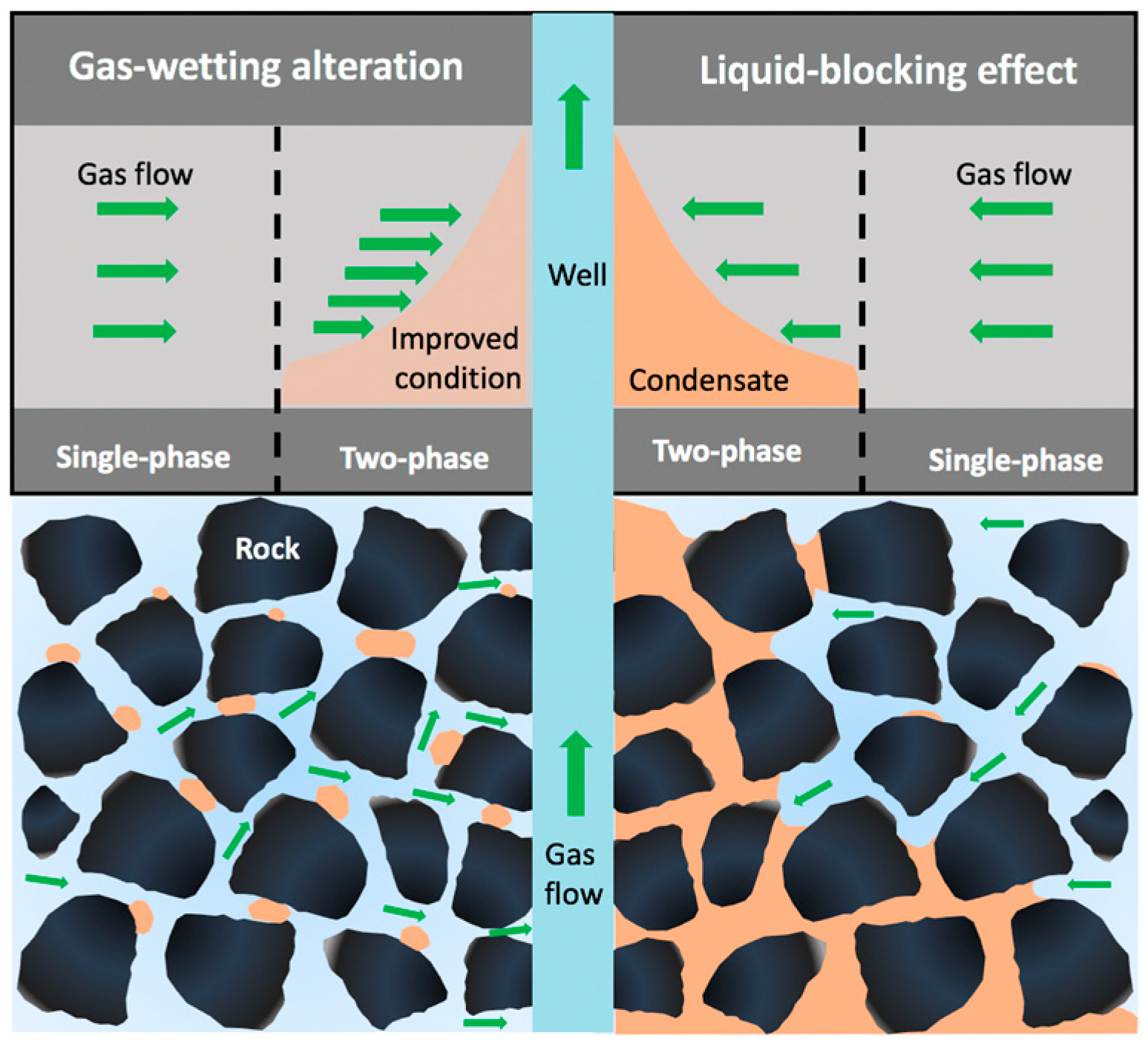

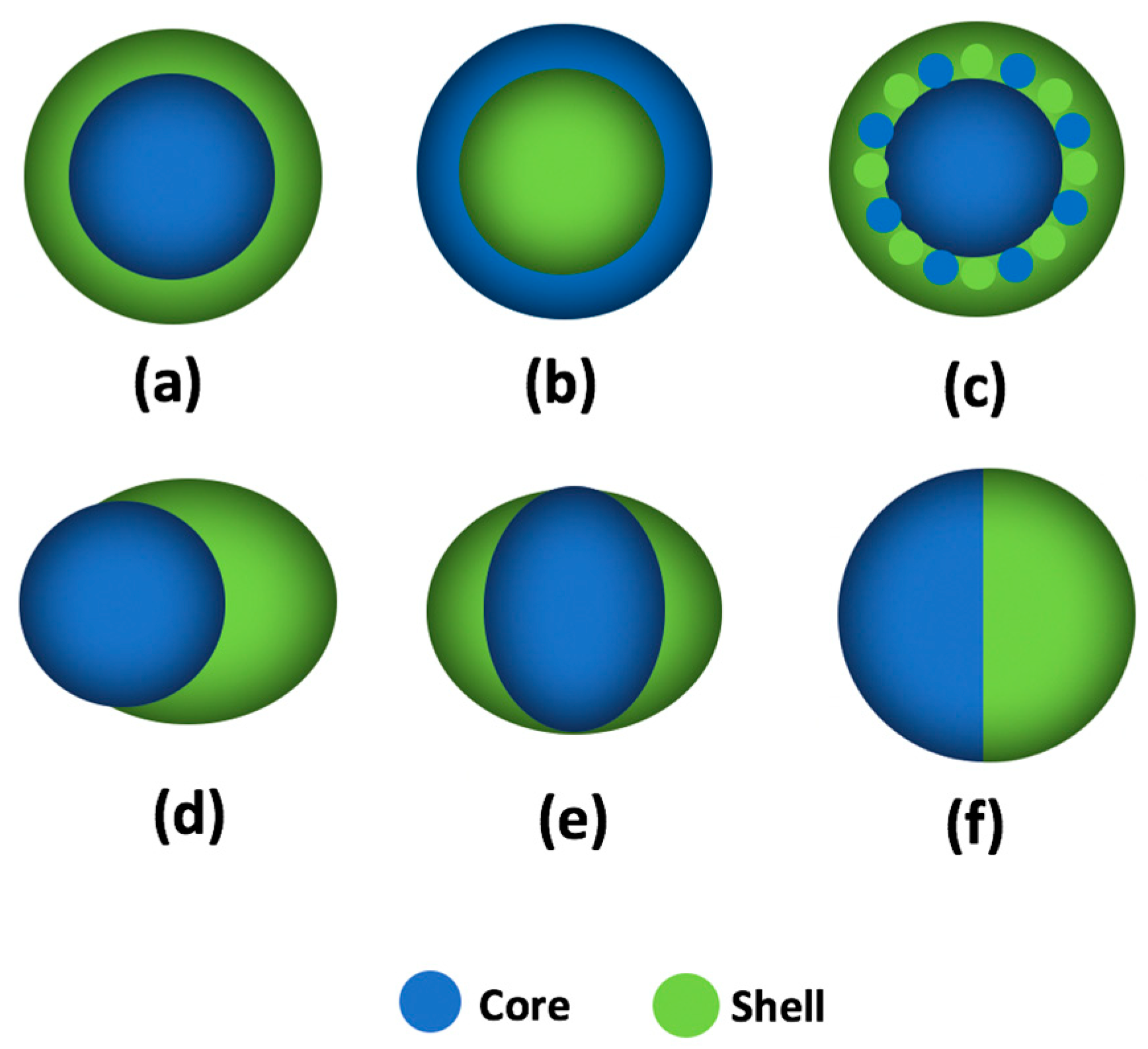

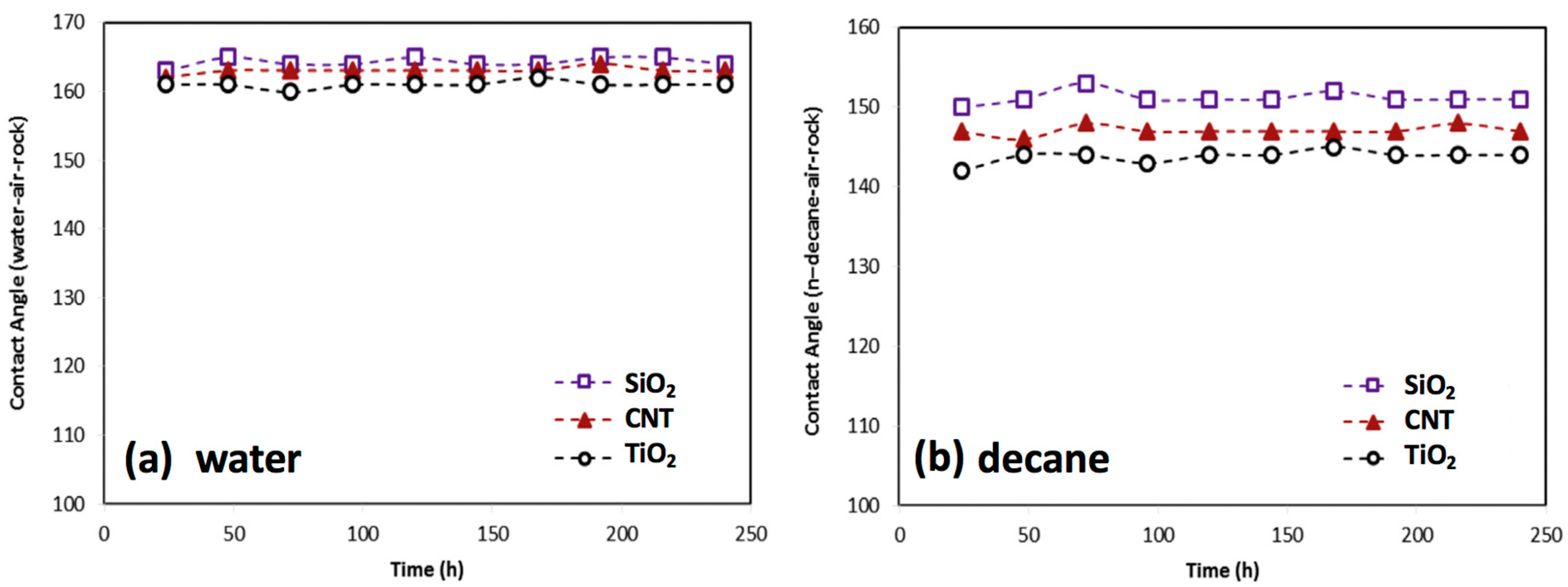
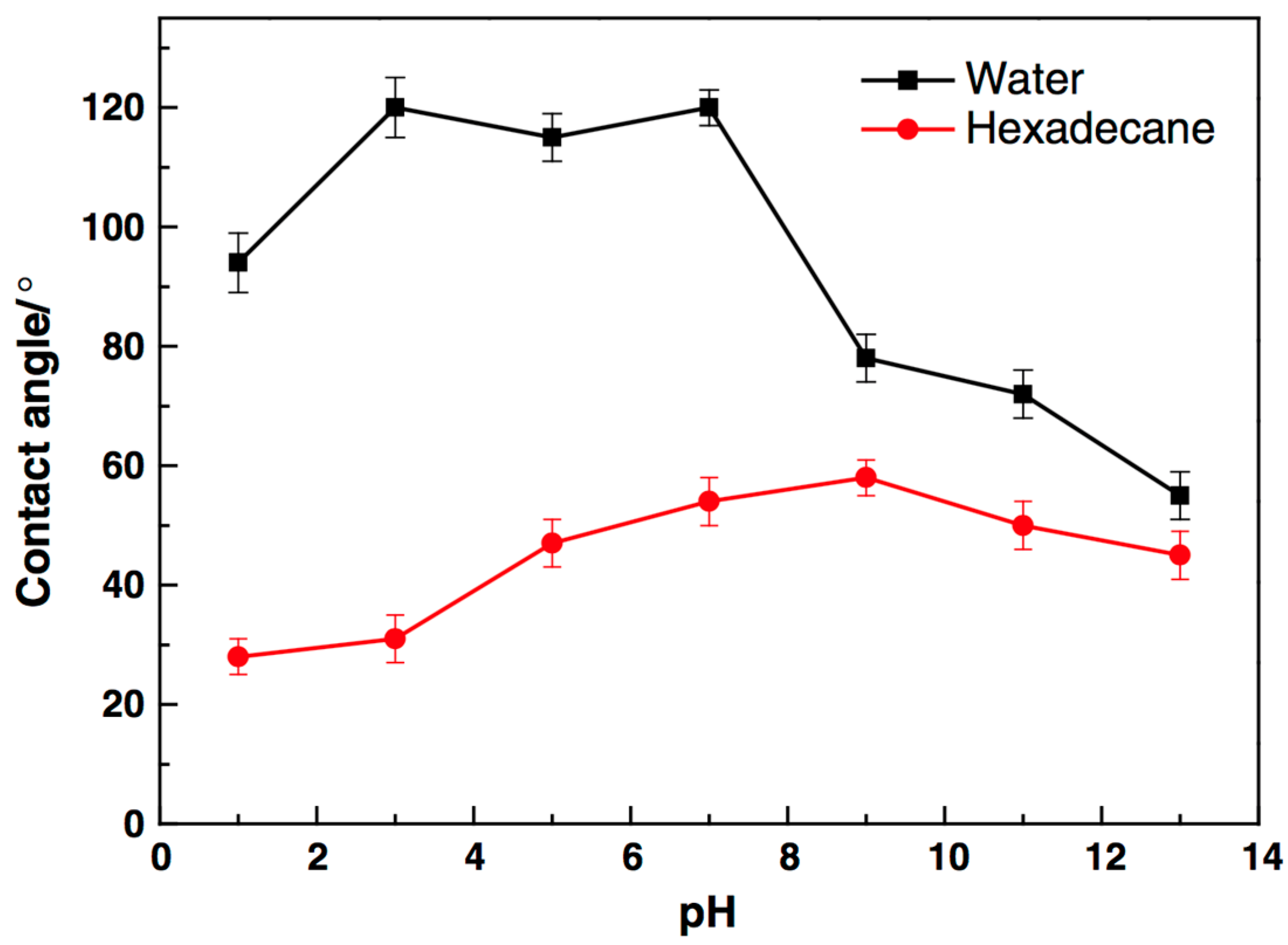
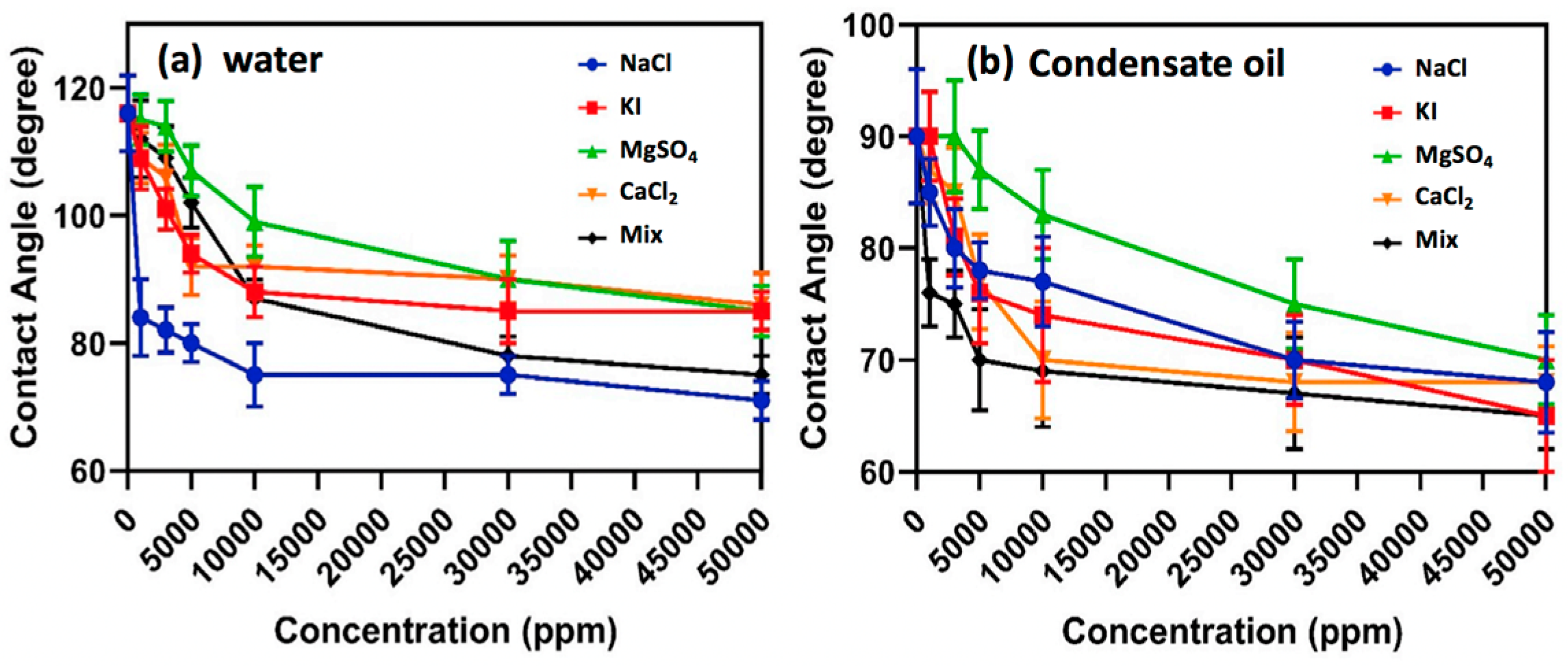
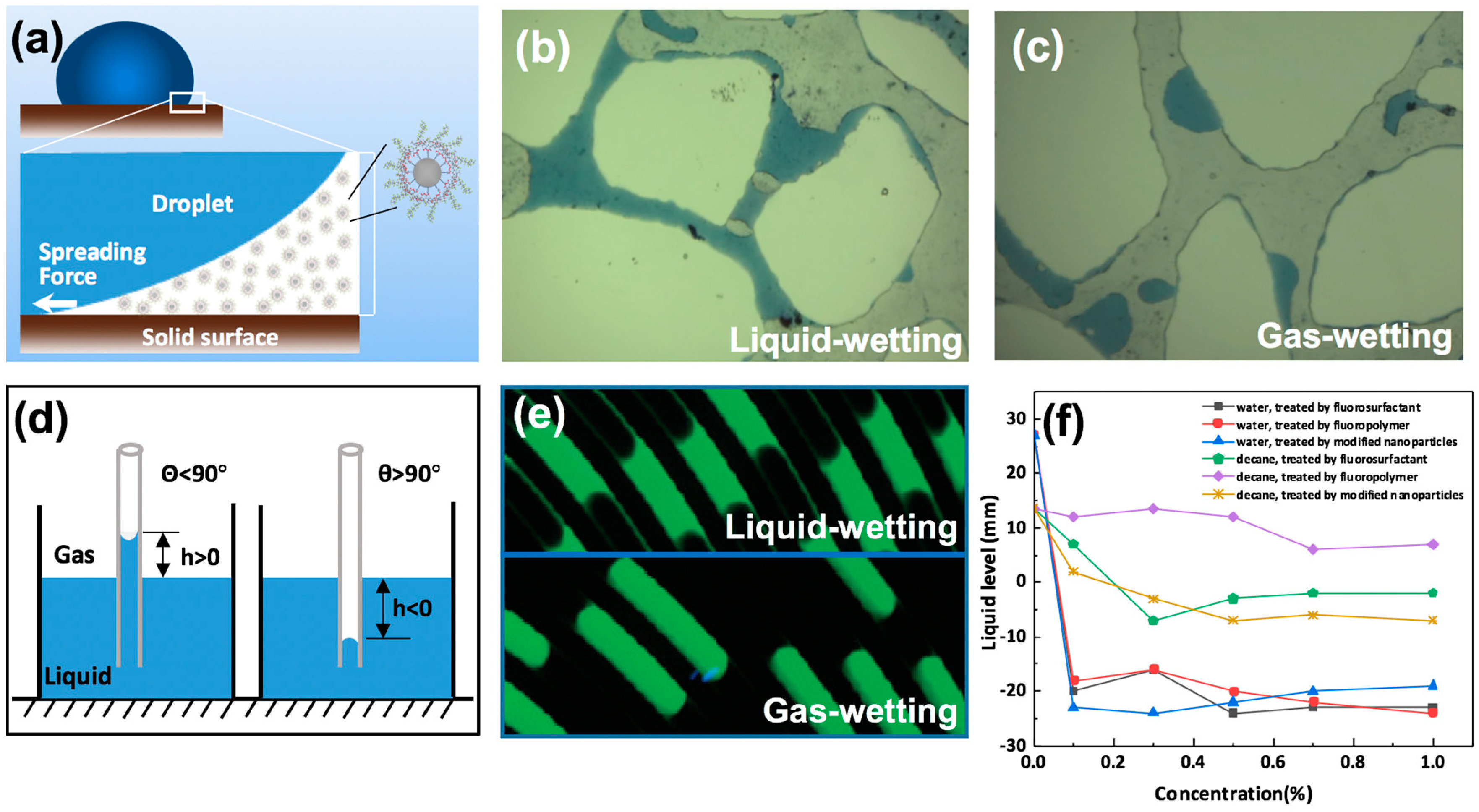
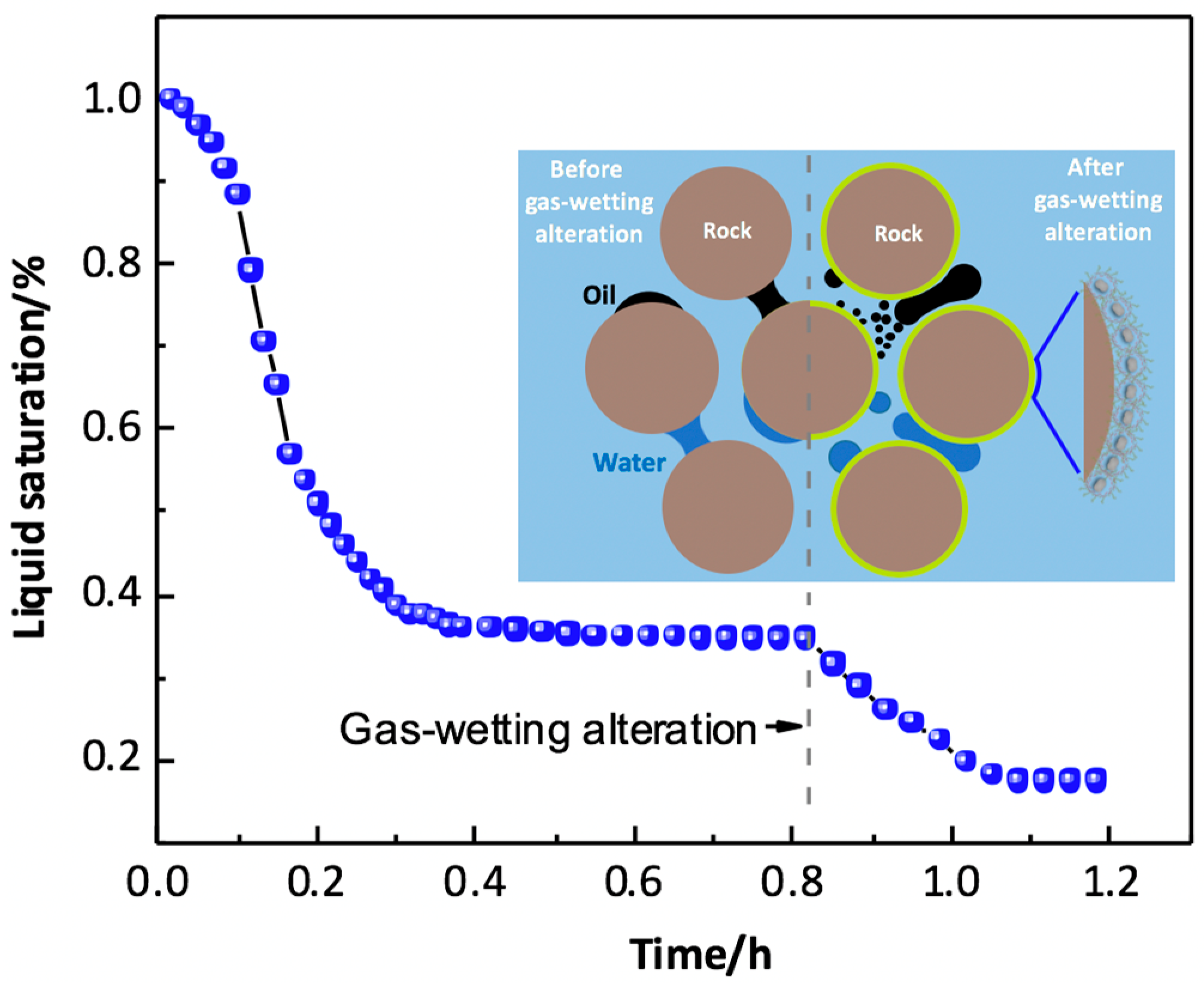

© 2020 by the authors. Licensee MDPI, Basel, Switzerland. This article is an open access article distributed under the terms and conditions of the Creative Commons Attribution (CC BY) license (http://creativecommons.org/licenses/by/4.0/).
Share and Cite
Jin, J.; Sun, J.; Rong, K.; Lv, K.; Nguyen, T.A.H.; Wang, R.; Huang, X.; Bai, Y.; Liu, J.; Wang, J. Gas-Wetting Alteration by Fluorochemicals and Its Application for Enhancing Gas Recovery in Gas-Condensate Reservoirs: A Review. Energies 2020, 13, 4591. https://doi.org/10.3390/en13184591
Jin J, Sun J, Rong K, Lv K, Nguyen TAH, Wang R, Huang X, Bai Y, Liu J, Wang J. Gas-Wetting Alteration by Fluorochemicals and Its Application for Enhancing Gas Recovery in Gas-Condensate Reservoirs: A Review. Energies. 2020; 13(18):4591. https://doi.org/10.3390/en13184591
Chicago/Turabian StyleJin, Jiafeng, Jinsheng Sun, Kesheng Rong, Kaihe Lv, Tuan A. H. Nguyen, Ren Wang, Xianbin Huang, Yingrui Bai, Jingping Liu, and Jintang Wang. 2020. "Gas-Wetting Alteration by Fluorochemicals and Its Application for Enhancing Gas Recovery in Gas-Condensate Reservoirs: A Review" Energies 13, no. 18: 4591. https://doi.org/10.3390/en13184591
APA StyleJin, J., Sun, J., Rong, K., Lv, K., Nguyen, T. A. H., Wang, R., Huang, X., Bai, Y., Liu, J., & Wang, J. (2020). Gas-Wetting Alteration by Fluorochemicals and Its Application for Enhancing Gas Recovery in Gas-Condensate Reservoirs: A Review. Energies, 13(18), 4591. https://doi.org/10.3390/en13184591







